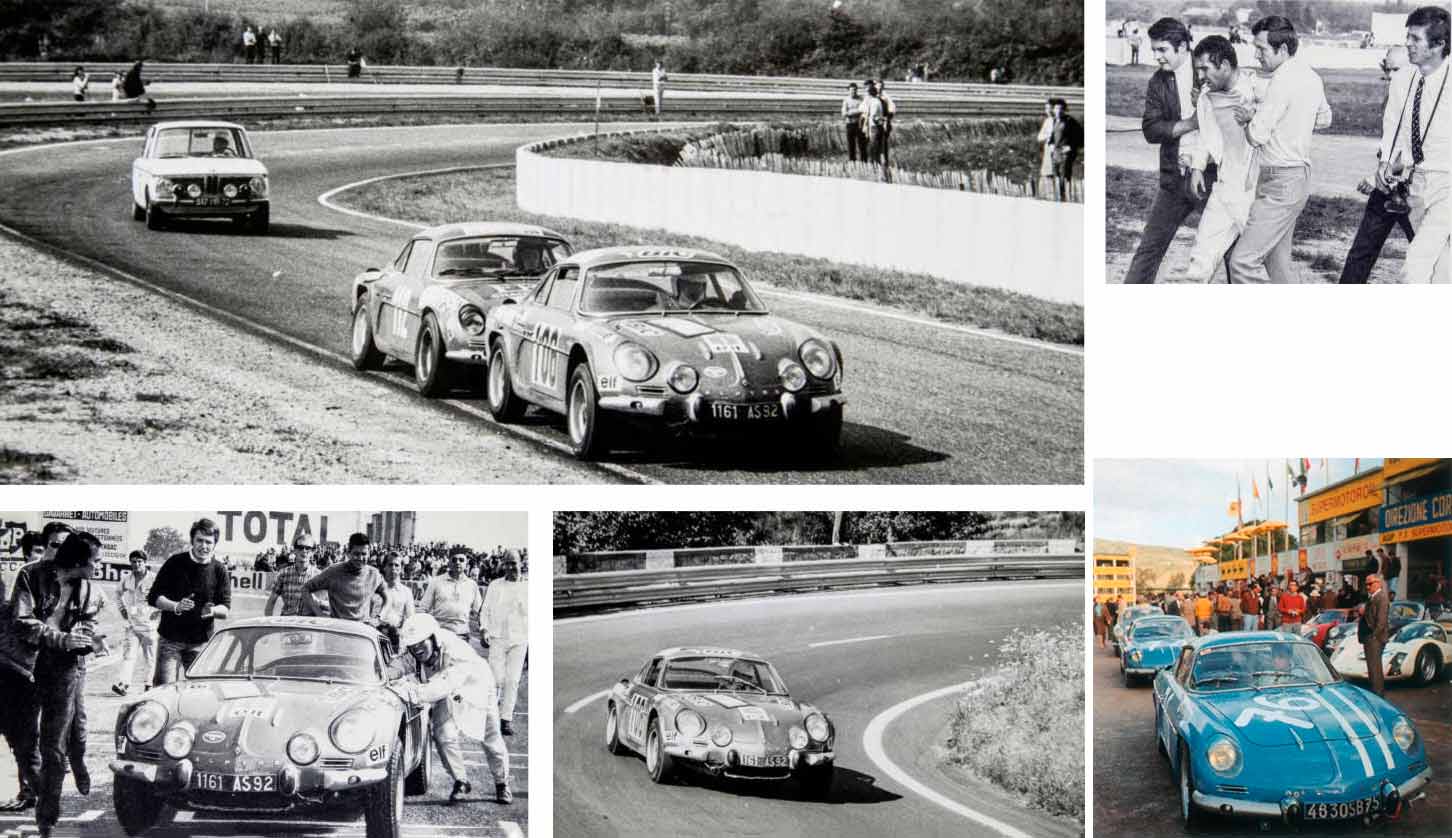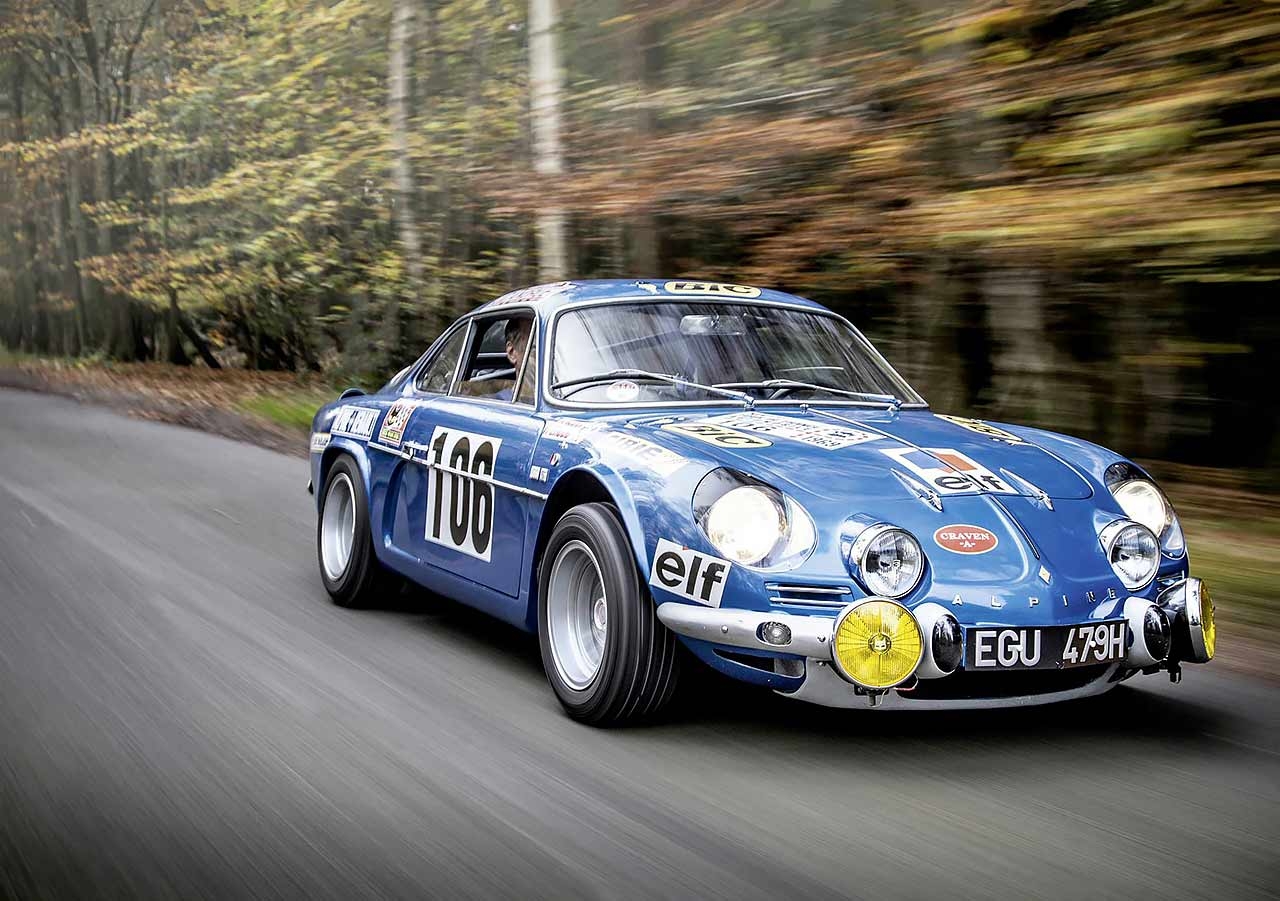
‘It doesn’t do slow’ Wild rally car, reader dream drive. Tim Fleckney has a passion for unusual French cars, so we put him in a genuine ex-works Alpine A110 rally car to see if it delivers the ultimate thrill? Words Sam Dawson. Photography Charlie Magee.
COVER The List Reader Tim Fleckney may have a Maserati in his garage but has long lusted after the Alpine-Renault A110. How did he get on with a driving a genuine ex-works rally car at full chat?
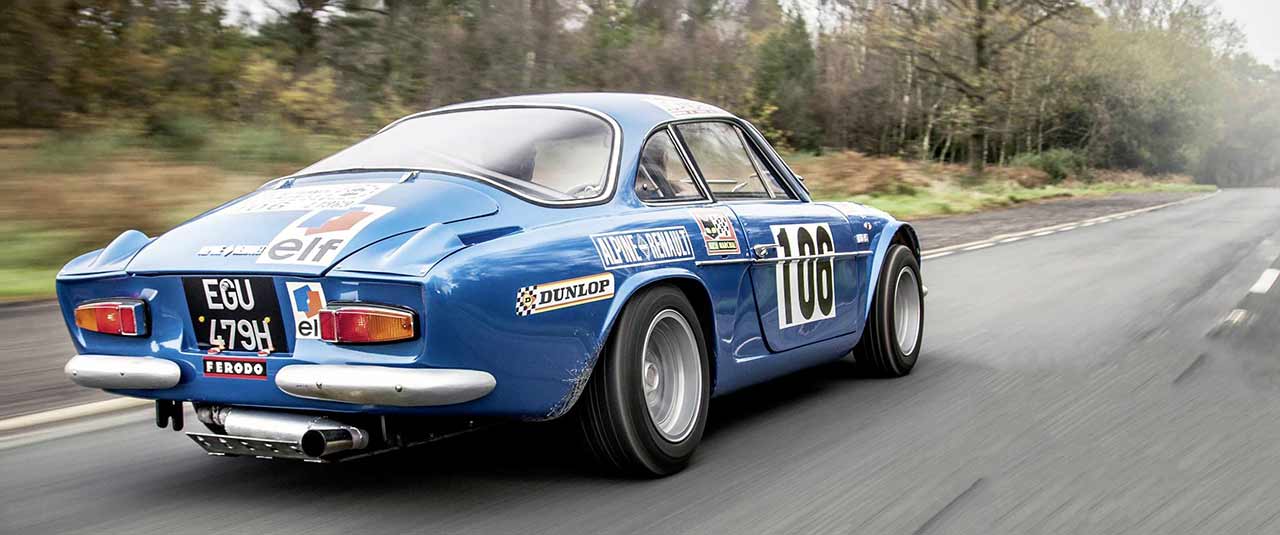
I always enjoy telling one of our readers that they’ve been chosen to drive one of their dream cars, but Tim Fleckney’s case is more special than most. He wanted to drive an Alpine- Renault A110, but I’ve managed to secure a genuine ex-works car with high-profile, star-driver history and a Marc Mignotetprepared 1447cc engine. Let’s face it, this is what you see when you visualise an A110 – blue, festooned with spotlights and adverts for French products, and slithering sideways down a snowy Col with a paragon of Gallic cool in anti-glare goggles at the wheel. Anything less is a dilution of the dream.
‘Most A110s are historic in some way, simply because the few made were nearly all intended for competition,’ Tim enthuses over a coffee at Biggin Hill aerodrome while we wait for the car to arrive. ‘But this one is an icon – a genuine ex-works rally car!’
I can scarcely believe it myself when the ex-Jean-Claude Andruet veteran of the dramatic and emotional 1969 Tour Auto jiggles over the speed humps into the car park, shafts of late-autumn sun causing its Bleu de France paint to glitter around its patriotic Elf, Marchal and Bic decals. This is the sort of car you expect to see in a museum or cordoned off behind a rope at Rétromobile, yet here it is, snapping and crackling at idle, its owner Nigel Burgess already gesturing Tim towards the driver’s seat.
Matra Murena owner Tim is eager to get settled. ‘I’ve always wanted to drive an A110 to complete the set, so to speak. I used to have a GTA Turbo but it broke down pretty much every time I drove it. Then back in the Nineties I spent the day with a bloke from Tavistock in Devon who was selling his A310 V6. I had a fantastic time testing it on Bodmin Moor but in the end decided that it was too old for me. I really wish I’d bought it now – he wanted only £4000 for it!
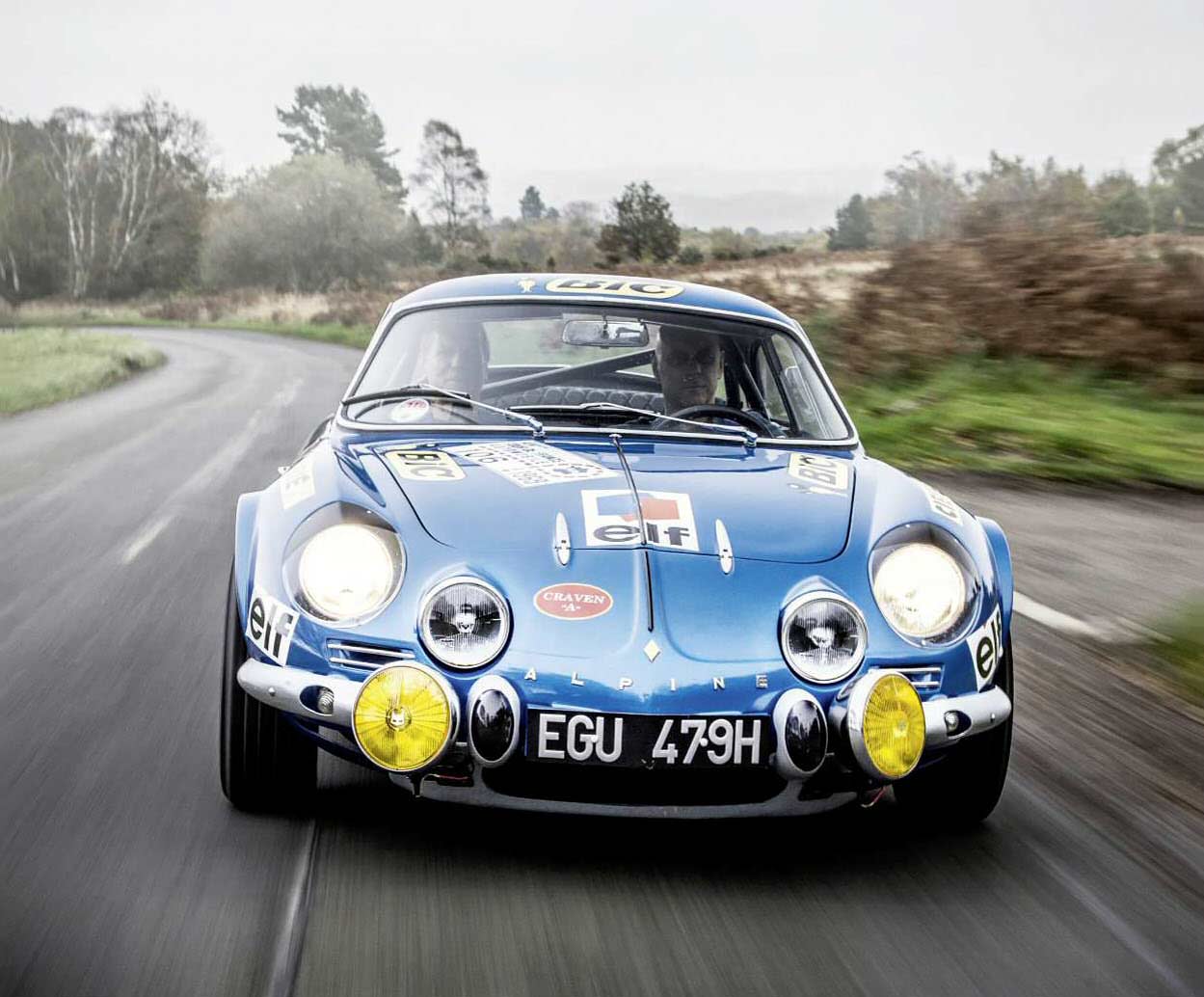
‘The Alpine A110 on the other hand was rare and out of reach even back then, and I’d heard it was a car you’d want to drive but not necessarily own. It’ll be interesting to see if a drive in this one changes my mind.’
‘You have to get in backwards,’ Nigel warns as Tim lifts his legs over the seat squab and squeezes himself into the cabin. ‘It’s really noisy in here,’ says Tim as he makes himself comfortable. ‘I’ve no idea how Vial and Andruet could have heard each other in here without an intercom system.’
He shifts into first gear and carefully edges away, but the competition-tuned engine clearly wants to rev and Tim is soon throwing the gearlever between third and fourth, the engine zinging its way to 4000rpm. He’s a picture of total concentration, hands clamped on the steering wheel, eyes locked on the horizon. Now’s not the time to interrupt him.
As we pause between driving stints, Tim reflects, ‘What defines the car for me is how small it is. I know I’ve got a Maserati Indy, but the whole big-engined excess thing has never really appealed to me. The A110 on the other hand is so pared-down and intensified that it concentrates every sensation.
‘It’s completely different to my old GTA. It’s built for a different purpose and feels it. It’s incredibly twitchy – I wouldn’t want to drive it on a loose surface. That rear engine feels like it could fling you sideways at any second, so you really have to concentrate. ‘You can’t drive it too gently, though. It needs to be revved and doesn’t do slow. It comes alive around 3000rpm, but will pull from 1000rpm in fifth gear, which is just as well because the shift pattern is weird. First and third are so close together that you risk mis-slotting them, but selecting fifth involves practically grazing your navigator’s left knee.’
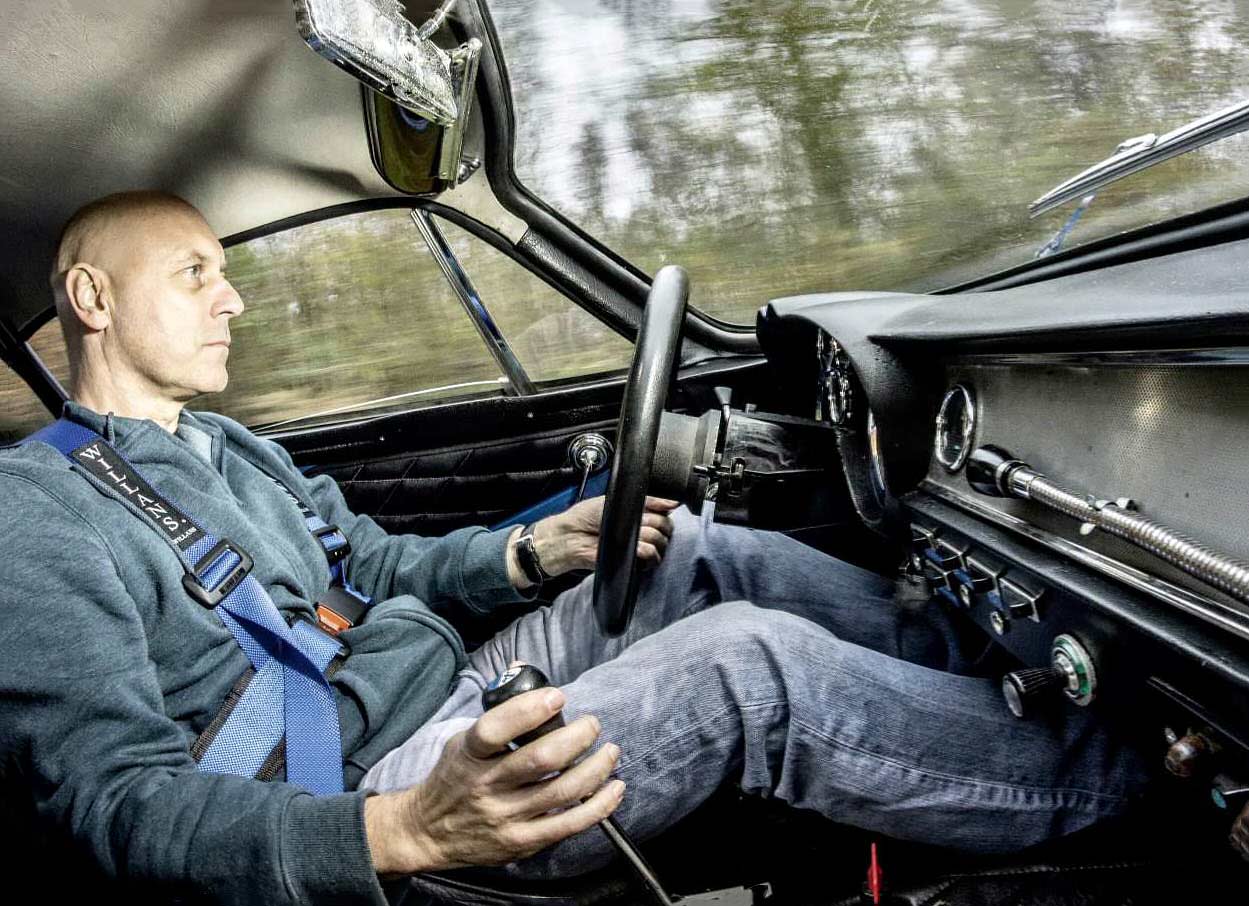
It’s my turn to drive, and if I’m honest I approach it with more than a little trepidation. For one thing, its driving position was designed around Jean-Claude Andruet – and he’s a lot shorter than I am. With the competition-spec long-distance fuel tank taking up all the space into which the driver’s seat would usually slide, I can’t liberate any more legroom for myself. There’s more headroom than I was expecting but my knees are splayed awkwardly around the steering wheel and my heels are crushed together in the bottom-left corner of the centrally skewed pedal box.
Speaking of which, having accelerator and brake pedals that practically overlap was doubtless ideal for Andruet’s masterful tap-dancing but forces me to operate the throttle with my big toe. Depressing the accelerator leaves my right foot stuck behind the brake pedal – I’ll have to think about braking very early in this car if I’m to avert disaster.
Despite all this, I’m soon glad I persevered – the A110’s unassisted steering is the purest I’ve ever experienced in a road car. At one and a half turns lock-to-lock and unencumbered by the weight of an engine, it makes the likes of the Porsche 911 and Lotus Elan seem heavy and long-winded by comparison.
The ultra-reclined seating position, funnelled footwell and deep bucket seat are more redolent of single-seater aesthetics than those of a rally car. Alpine founder Jean Rédélé was looking to enter Formula One at about the time the A110 was designed, and while it’s best known as a rally car, he always wanted it to be just as effective on the racetrack. And it shows.
This car is happy to potter around at low revs even in the higher gears, but get it past 3000rpm and the engine note suddenly morphs into a ragged-edged rapid-fire cackle, each spark producing a gunshot from the exhaust.
I was expecting the rear-engined A110 to handle rather like a 911, but the lightweight engine sits on the rear axle line rather than behind it, so it lacks the Porsche’s pendulum effect during hard cornering. Stiff, roll-resisting suspension means it’s a model of utter simplicity – the front provides steering feedback, the rear grip and propulsion. Lifting off or braking hard mid-corner is still a no-no, but you don’t have to fight it. In fact, it must be one of the most compliant chassis set-ups ever devised.
However, there’s a sense that it’s in a state of perfect balance and that if the wheels were wider or the engine more powerful – as later Group 4-homologated versions of the A110 were – this sense of equilibrium would be corrupted. It’s no long-distance cruiser, either; this is a car best experienced in brief, intense hits – more espresso than americano – and all the better for it.
‘Would you buy one?’ I ask Tim. ‘Not to replace my Maserati,’ he says, ‘but possibly the Matra. It’s clearly built for competition, and that’s precisely what I’d use it for. I’d love to take it on track to see what it’s really capable of at full chat. If I owned a warehouse full of cars for every purpose, there would definitely be an A110 in there.’
Thanks to: Nigel Burgess, Stephen Dell, Renault Alpine Owners’ Club Overleaf: 1969 Tour Auto remembered
Tech and photos
TECHNICAL DATA FILE SPECIFICATIONS 1969 ALPINE-RENAULT A110
Engine 1447cc in-line four-cylinder, ohv, twin Weber 40 DCOE carburettors
Power and torque 145bhp @ 7300rpm; 118lb ft @ 5500rpm / DIN
Transmission Five-speed manual, rear-wheel drive
Brakes Discs front and rear
Suspension Front: independent, double wishbones, coil springs, telescopic dampers, anti-roll bar. Rear: independent, semi-trailing arms, coil springs, telescopic dampers Steering Rack and pinion
Weight 605kg
Performance Top speed: 143mph; 0-60mph: 9.1sec
Fuel consumption 21mpg
Cost new £2025
Current value £85,000

‘The competition-tuned engine clearly wants to rev and is soon zinging its way to 4000rpm’
TIM FLECKNEY
Climate control engineer Tim’s List has a rallying slant to it, though his interests are distinctly Franco- Italian – a Maserati Indy shares garage space with a Matra Murena. He has an ‘accidental’ collection of Daihatsu hot hatches and his daily driver is a Citroën BX GTi.
HIS WISHLIST
Iso Grifo
Lamborghini Espada
Lancia 037
MG Metro 6R4
Lancia Delta S4
Alpine-Renault A110
Citroën SM
Alfa Romeo Junior Zagato
Alfa Romeo SZ
Citroën CX GTi Turbo
THE EVOLUTION
1962 A110 1000
The original A110 looks superficially similar to the previous A108, which was designed by Giovanni Michelotti, but is now based mechanically on the new Renault R8 and features four-wheel disc brakes and a 55bhp 956cc engine. An 1108cc engine is included on the options list to obtain FIA homologation papers, although none is actually built.
1963 A110 1100 TOUR DE FRANCE
The original A110 looks superficially similar to the previous A108, which was designed by Giovanni Michelotti, but is now based mechanically on the new Renault R8 and features four-wheel disc brakes and a 55bhp 956cc engine. An 1108cc engine is included on the options list to obtain FIA homologation papers, although none is actually built.
1965 A110 1300
Seeking to outpace the 1300cc-class Abarths, Alpine engineer Richard Bouleau modifies the 1108cc engine using Peugeot 203 pistons, sleeved bores and machined hemispherical combustion chamber cylinder heads to create a race-ready 1295cc engine. A 1447cc unit prepared by Marc Mignotet is available to special order and a five-speed gearbox becomes an option.
1966 A110 1500
Just 44 1470cc Alpines are built, using the engine Renault designed for the Lotus Europa. It has an aluminium cylinder head and two Solex carburettors, pushing out a full 90bhp. The engine block is larger than the 1300’s so the radiator has to be shifted to the nose of the car, which itself is modified at the same time to accommodate four headlights.
1969 A110 1600
Gérard Larrousse wins the 1967 Rallye Bayonne-Côte Basque in a prototype 1608cc Mignotet-engined car, prompting Alpine to put it into full production and call it the A110S. Increasing success means that Alpine has effectively outgrown its old Rue Forest factory. Subsequent official adoption by Renault funds the construction of a brand-new factory in Dieppe.
1970 A110 GROUP 4 USINE
New Group 4 rules spur Alpine-Renault into creating wide-arched, high-power rally cars, including rally-ready 1300 and 1600S models, and the works teams run Mignotet-prepared 1.8-litre engines. Production continues until 1977 and an 1860cc turbocharged variant becomes the first turbo car to win a rally on the 1972 Critérium des Cevennes.
THE ECSTASY AND AGONY OF CAR 106
This Alpine-Renault could have scored one of the marque’s greatest victories, but it wasn’t to be…
The Fédération Française du Sport Automobile complicated matters for Alpine midway through 1969. After a five-year hiatus most considered permanent, it was announced that the epic Tour de France Auto – five-days of races, hill climbs and regularity rallying – would run again after former winner Bernard Consten persuaded Bic, Dunlop, Elf and BP to sponsor it.
Unfortunately for Alpine, the competition budget for the year had already been spent, but when Alpine works co-driver Michel Vial learned that Porsche was backing Gérard Larrousse in the latest 911R, he used his own money to prepare a Mignotettuned 1440cc Alpine A110 1300, and mounted an assault on the event together with star driver Jean-Claude Andruet. Vial would drive the regularities, Andruet the circuits and hill climbs.
By the Mont Rivard stage at the end of the first day Andruet was in third, just 20 seconds behind Larrousse’s leading Porsche, but his pace slackened halfway through the Tour when his choice of wet-weather tyres backfired at Clermont-Ferrand and his pit stop dropped him to fourth in class behind a trio of Mini Coopers led by Paddy Hopkirk.
He was back on form by Col du Minier and finished second behind Larrousse. Into the final day Larrousse was facing serious competition from his Porsche team-mate Guy Chasseuil. The stage was set for a showdown at Nogaro on the Spanish border. Andruet was on course for a class win and maybe a chance to beat Larrousse.
Andruet surged ahead of Jean-François Piot’s Ford Capri RS2300 but after a few laps his Alpine suffered engine failure. Then, one by one, privateer Alpine drivers closed in on the back of Andruet’s car and pushed it round the circuit to ensure he completed enough laps to finish the race. Andruet jumped out of the car on the final straight and pushed it the final kilometre uphill.
Upon finally crossing the finish line, Andruet was told by officials that he’d been disqualified for ‘receiving assistance’. Exhausted by the final push and three consecutive days without sleep, the inconsolable Andruet (above left) collapsed as Larrousse and Porsche took the trophy. But the grandstands cheered for Andruet and Vial, and an incredible display of heroism and sportsmanship.
